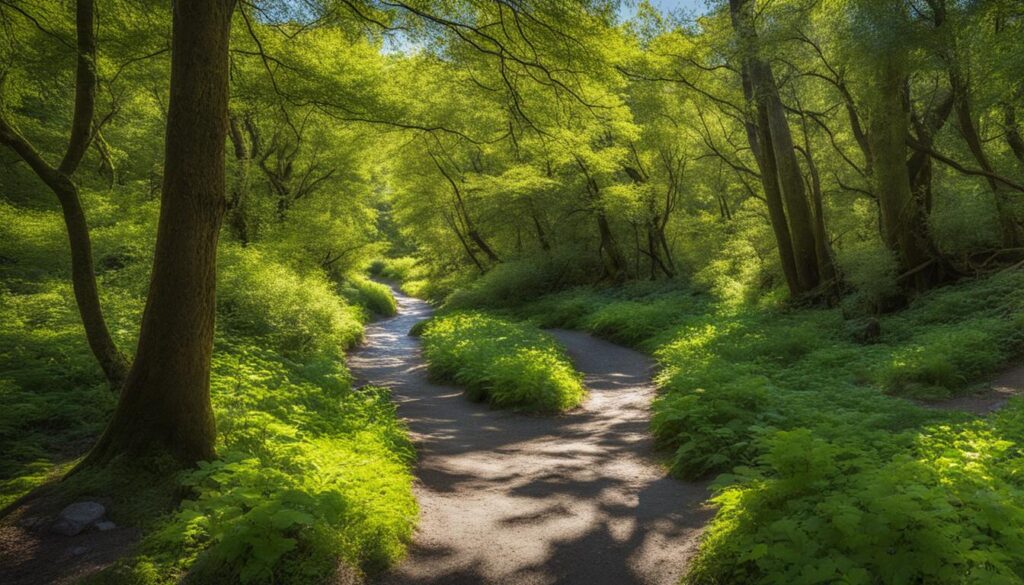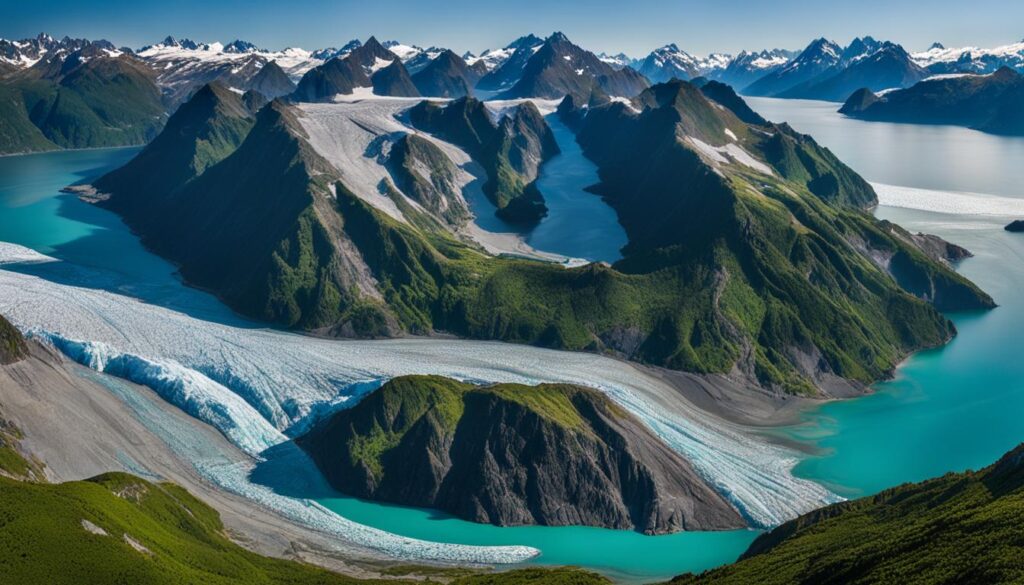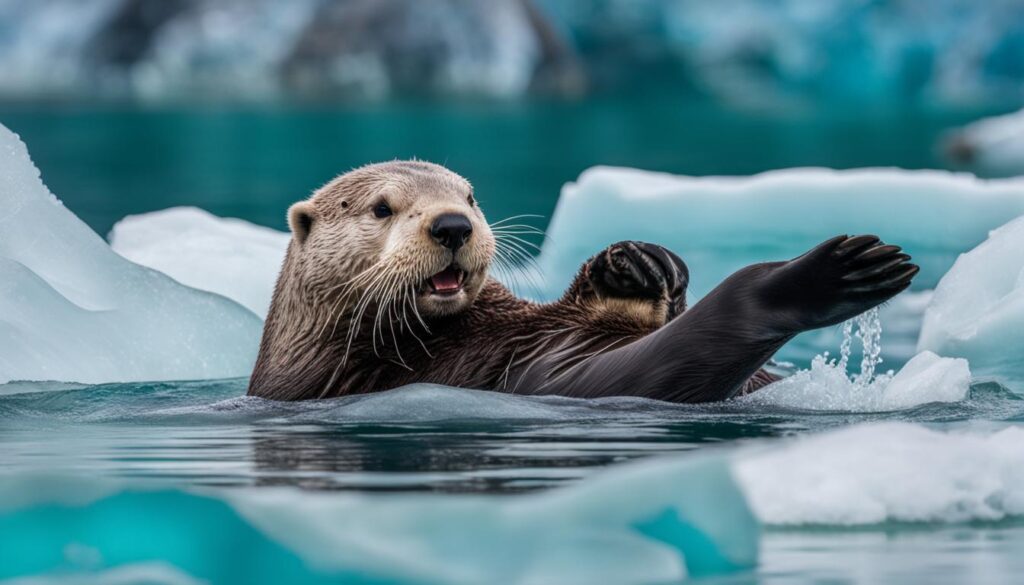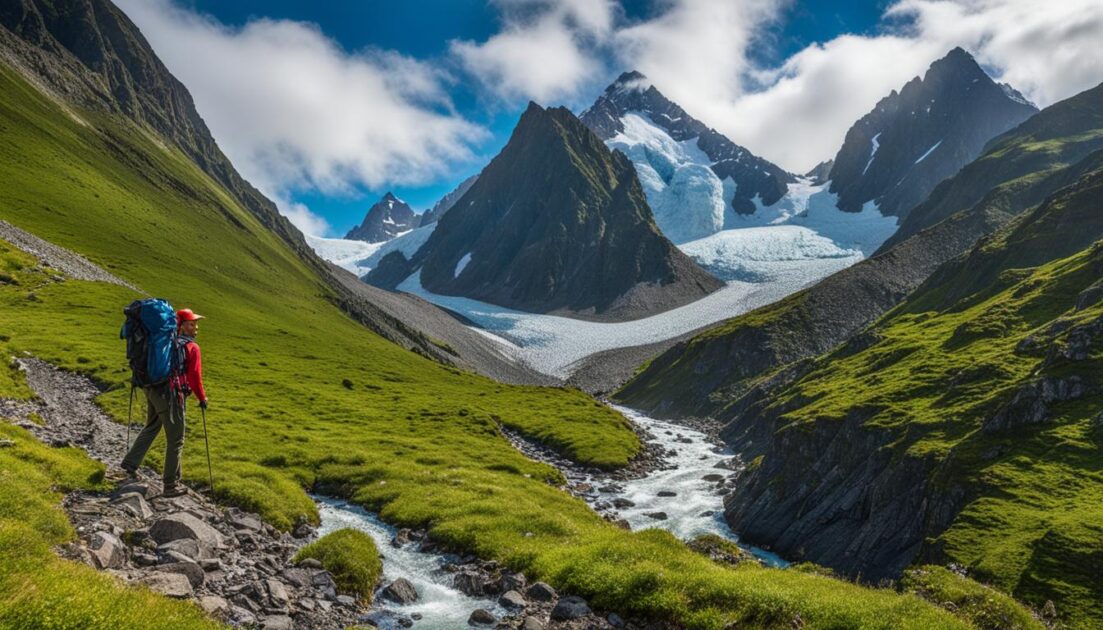As an avid hiker, I am always on the lookout for new and exciting trails to explore. When it comes to breathtaking landscapes and unparalleled natural beauty, Kenai Fjords National Park in Alaska immediately comes to mind. With its vast wilderness, mesmerizing glaciers, and abundant wildlife, it offers a hiking experience unlike any other.
Whether you’re a beginner or a seasoned hiker, Kenai Fjords has something for everyone. From easy trails that provide stunning views to more challenging treks that push your limits, this national park has it all. To make the most of your hiking adventure, it’s important to be well-prepared and understand the seasonal variations in weather and wildlife.
Key Takeaways:
- Kenai Fjords National Park offers a range of hiking trails suitable for all levels of experience.
- Easy trails like the Exit Glacier View Loop and Resurrection River Trail provide beautiful views and wildlife spotting opportunities.
- Harder trails like the Harding Icefield Trail offer breathtaking panoramas but require more physical fitness.
- Consider the differences between summer and winter hiking in terms of daylight, weather, and crowd levels.
- Kenai Fjords National Park is not only a scenic wonderland, but it also holds significant historical and geological value.
Easy Hiking Trails in Kenai Fjords National Park

Kenai Fjords National Park offers several easy hiking trails that provide beautiful views and opportunities to spot wildlife. One of the most popular easy hikes is the Exit Glacier View Loop, which is a stroller and wheelchair accessible trail showcasing views of the Exit Glacier. Another option is the 4.5-mile Resurrection River Trail, which is relatively flat and perfect for leisurely walks through the park. These easy trails are ideal for beginners or those looking for a more relaxed hiking experience.
Trail Name: Exit Glacier View Loop
| Trail Difficulty | Trail Length | Accessibility |
|---|---|---|
| Easy | 1.9 miles | Stroller and wheelchair accessible |
Trail Name: Resurrection River Trail
| Trail Difficulty | Trail Length | Accessibility |
|---|---|---|
| Easy | 4.5 miles | Accessible for most hikers |
These trails offer a chance to immerse yourself in the stunning natural beauty of Kenai Fjords National Park without the need for advanced hiking skills. Whether you want to enjoy a casual stroll or introduce your family to the world of hiking, these easy trails are a great choice. Don’t forget to bring your camera to capture the breathtaking views and potential wildlife sightings along the way.
Hard Hiking Trails in Kenai Fjords National Park

Kenai Fjords National Park offers a variety of hard hiking trails that are perfect for experienced hikers seeking a challenge. These trails provide incredible views and the opportunity to immerse yourself in the park’s rugged beauty.
One of the most renowned hard trails in Kenai Fjords National Park is the Harding Icefield Trail. This 8.2-mile trek offers a strenuous but rewarding experience, with an elevation gain of over 1,000 feet. As you ascend, you’ll be treated to breathtaking panoramic views of the park and the stunning Exit Glacier. The trail takes you through alpine meadows, past cascading waterfalls, and up to the icy expanse of the Harding Icefield. It’s a truly unforgettable adventure for those seeking a challenging hike.
Another notable hard trail in the park is the Caines Head Coastal Trail. This 4.5-mile trail takes you along the coastline, offering stunning views of Resurrection Bay and its surrounding mountains. The trail features steep ascents and descents, rocky terrain, and the opportunity to explore the historic Fort McGilvray. The challenging nature of this trail makes it suitable for experienced hikers looking for a thrilling and rewarding expedition.
When hiking on these challenging trails, it’s important to come prepared with the right gear, including sturdy hiking boots, layers of clothing, a map, compass, and plenty of water and snacks. It’s also advisable to hike with a partner or in a group for added safety. Remember to always stay on the designated trails and be aware of your surroundings and the potential presence of wildlife.
Table: Comparison of Hard Hiking Trails
| Trail | Difficulty | Distance | Elevation Gain | Highlights |
|---|---|---|---|---|
| Harding Icefield Trail | Hard | 8.2 miles | 1,000+ feet | Panoramic views, Exit Glacier, Harding Icefield |
| Caines Head Coastal Trail | Hard | 4.5 miles | Varies | Coastline views, Fort McGilvray |
These hard hiking trails in Kenai Fjords National Park offer an incredible opportunity to challenge yourself and witness the park’s awe-inspiring landscapes. Whether you choose to tackle the Harding Icefield Trail or explore the Caines Head Coastal Trail, be prepared for a demanding but immensely rewarding adventure in the heart of Alaska’s natural wonders.
Hiking in Kenai Fjords National Park: Summer vs Winter

Hiking in Kenai Fjords National Park offers a unique and ever-changing experience depending on the season. During the summer months, the park comes alive with longer daylight hours, mild temperatures, and vibrant vegetation. It’s the perfect time to explore the numerous hiking trails and immerse yourself in the stunning beauty of the park. From easy walks to challenging treks, there’s something for hikers of all levels.
Summer hiking in Kenai Fjords National Park not only allows you to witness the lush greenery and blooming wildflowers but also offers the chance to spot wildlife such as bears, moose, and a variety of bird species. However, it’s important to be prepared for larger crowds on popular trails, especially during peak tourist season. It’s advisable to plan your hikes early in the day to avoid the heaviest foot traffic.
“Summer is a fantastic time to explore Kenai Fjords National Park on foot. The vibrant colors and abundant wildlife make for an unforgettable hiking experience.” – Experienced Hiker
On the other hand, hiking in Kenai Fjords National Park during the winter months offers a different kind of beauty and solitude. The park is transformed into a winter wonderland, with snow-covered landscapes and frozen waterfalls. The peacefulness of the park during this time allows for a more serene hiking experience, where you can truly connect with nature.
Winter hiking requires proper preparation and gear to ensure safety and enjoyment. It’s essential to dress in layers, wear sturdy waterproof boots, and carry necessary equipment such as trekking poles and crampons for icy terrain. The shorter daylight hours and lower temperatures also mean that hikers should plan their outings accordingly and be aware of changing weather conditions.
“Winter hiking in Kenai Fjords National Park is a magical experience. The pristine landscapes and the chance to spot wildlife in the snow make it worth braving the cold.” – Adventurous Hiker
| Summer Hiking | Winter Hiking |
|---|---|
| Longer daylight hours | Shorter daylight hours |
| Mild temperatures | Colder temperatures |
| Lush vegetation | Snow-covered landscapes |
| Possibility of wildlife sightings | Possibility of wildlife sightings |
Whether you choose to hike in the summer or winter, Kenai Fjords National Park offers a truly remarkable experience. Each season unveils its own unique beauty, and both provide ample opportunities to connect with nature and create lasting memories.
Historical Significance and Geological Wonders in Kenai Fjords National Park

Kenai Fjords National Park is not just a feast for the eyes with its stunning landscapes; it also holds significant historical and geological importance. The park’s glaciers, remnants of the last ice age, offer a fascinating glimpse into the Earth’s past. Exploring these icy wonders allows visitors to connect with the natural history of our planet.
One of the park’s most remarkable geological features is the Harding Icefield, the largest ice field entirely within the United States. Spanning over 700 square miles, this massive expanse of ice serves as a majestic testament to the power and beauty of nature. It’s an awe-inspiring sight that leaves a lasting impression on anyone fortunate enough to witness it.
The Harding Icefield: A Frozen Paradise
The Harding Icefield is a marvel of nature, and its grandeur is best appreciated up close. Hiking the Harding Icefield Trail, a rigorous 8.2-mile trek, rewards adventurers with panoramic views of the ice field and the surrounding landscapes. The trail climbs through lush forests, rocky ridges, and finally emerges onto the icefield itself. Standing atop the Harding Icefield, with its glistening expanse stretching as far as the eye can see, is an experience that truly puts the magnitude of this natural wonder into perspective.
The Harding Icefield Trail is not for the faint of heart, and hikers must be well-prepared. It’s crucial to bring proper gear, including sturdy hiking boots, warm clothing, and plenty of water. Remember to check weather conditions and trail updates before embarking on the hike. Safety should always be a priority when exploring the geological wonders of Kenai Fjords National Park.
Table: Geological Wonders in Kenai Fjords National Park
| Geological Feature | Description |
|---|---|
| Glaciers | Remnants of the last ice age, these massive rivers of ice shape the landscape of the park and offer a captivating display of nature’s power. |
| Harding Icefield | The largest ice field entirely within the United States, spanning over 700 square miles and showcasing the beauty and resilience of glaciers. |
| Fjords | Carved by glaciers over thousands of years, the fjords of Kenai Fjords National Park create dramatic landscapes of steep cliffs, deep waters, and hidden coves. |
| Coastal Landforms | The park’s coastal area is home to sea stacks, arches, and other fascinating formations shaped by the forces of wind, water, and time. |
The geological wonders of Kenai Fjords National Park offer not only breathtaking views but also a humbling reminder of our planet’s rich history. Exploring these wonders is an opportunity to connect with nature on a deeper level and to appreciate the remarkable forces that have shaped the landscapes we admire today.
Abundant Wildlife in Kenai Fjords National Park

Kenai Fjords National Park is a haven for wildlife enthusiasts, offering unparalleled opportunities to observe a diverse range of species in their natural habitat. From majestic bears to graceful whales, the park is home to a rich and vibrant ecosystem that never fails to impress.
One of the highlights of visiting Kenai Fjords National Park is the chance to witness the impressive marine life that calls these waters home. Whale watching is a popular activity, with sightings of humpback, killer, and gray whales being common, especially during the summer months. The park’s coastline also provides a unique habitat for seals, sea lions, and otters, which can often be seen lounging on rocky outcrops or frolicking in the waves.
“The wildlife in Kenai Fjords National Park is truly awe-inspiring. I had the incredible experience of spotting a mother bear and her cubs while hiking one of the park’s trails. It was a moment I will never forget – seeing these majestic creatures in their natural habitat was a privilege.”
While exploring the park’s lush forests and meadows, it is not uncommon to come across other iconic Alaskan wildlife, such as moose and eagles. The park’s diverse bird population includes species like puffins, bald eagles, and various seabirds, making it a haven for birdwatching enthusiasts.
| Animal | Habitat | Notable Features |
|---|---|---|
| Black Bears | Forests and meadows | Distinctive black fur |
| Grizzly Bears | Coastal regions and river valleys | Powerful and muscular build |
| Moose | Wetlands and meadows | Impressive antlers |
| Whales | Coastal waters | Massive size and spouting blowholes |
| Seals and Sea Lions | Rocky coastal areas | Playful nature and distinctive barks |
| Otters | Marine and freshwater habitats | Sleek bodies and playful behavior |
| Puffins | Coastal cliffs and islands | Colorful beaks and ability to swim and fly |
| Bald Eagles | Forests and coastal areas | Majestic appearance and sharp talons |
| Seabirds | Coastal cliffs and rocky outcrops | Diverse species and impressive diving abilities |
Whether you’re an avid wildlife photographer or simply a nature lover, Kenai Fjords National Park offers an abundance of opportunities to witness the beauty and wonder of Alaska’s wildlife. Remember to always observe animals from a safe distance and be respectful of their natural habitats to ensure their preservation for future generations.
Scenic Viewpoints in Kenai Fjords National Park

One of the most captivating aspects of exploring Kenai Fjords National Park is the opportunity to witness its awe-inspiring scenic viewpoints. From these vantage points, hikers can take in the breathtaking beauty of the park’s landscapes, glaciers, and wildlife. Whether you’re looking for panoramic vistas or intimate glimpses of nature, there are a variety of viewpoints that offer unforgettable experiences.
One of the must-visit scenic viewpoints is along the Harding Icefield Trail. This challenging hike rewards adventurers with sweeping views of the vast expanse of the Harding Icefield. As you ascend, the trail unveils breathtaking panoramas of the surrounding mountains and glaciers. It’s a humbling experience to witness the sheer magnitude of the icefield and appreciate the forces that have shaped this remarkable landscape.
For a more intimate encounter with the impressive Exit Glacier, the Exit Glacier Overlook Trail provides an excellent viewpoint. This trail leads hikers through lush forests before revealing a stunning perspective of the glacier. The juxtaposition of the icy blue hues against the rugged mountains creates a picture-perfect scene that is sure to leave a lasting impression.
| Scenic Viewpoint | Description |
|---|---|
| Harding Icefield Trail | A challenging hike offering panoramic views of the Harding Icefield, surrounding mountains, and glaciers. |
| Exit Glacier Overlook Trail | A trail leading to an overlook with stunning views of the Exit Glacier and the surrounding landscape. |
No matter which scenic viewpoint you choose to explore, be sure to bring your camera to capture the captivating beauty of Kenai Fjords National Park. These viewpoints provide a glimpse into the park’s extraordinary natural wonders and serve as a reminder of the importance of preserving these pristine environments for future generations to enjoy.
Trip Planning and Safety in Kenai Fjords National Park

When embarking on a hiking adventure in Kenai Fjords National Park, proper trip planning and safety precautions are paramount to ensure a safe and enjoyable experience. Here are some essential tips to keep in mind:
1. Familiarize yourself with trail maps and conditions
Before hitting the trails, take the time to familiarize yourself with trail maps and current conditions. This will help you choose the most suitable route for your hiking level and ensure that you stay on the right path. Pay attention to any potential hazards or closures that may be in effect and plan your hike accordingly.
2. Pack essential items and be prepared
Make sure to pack essential items to ensure your safety and comfort during the hike. These may include proper hiking gear, sturdy footwear, layers of clothing, a hat, sunscreen, bug spray, a map and compass, a first aid kit, food, and plenty of water. It’s also a good idea to check the weather forecast before heading out and dress accordingly.
3. Hike with a partner or in a group
It’s always safer to hike with a partner or in a group, especially in remote or less-frequented areas of the park. Having someone with you can provide an extra set of eyes and assistance in case of emergencies. If hiking alone, be sure to let someone know your hiking plans, including your intended route and expected time of return.
4. Be mindful of wildlife and follow park regulations
Kenai Fjords National Park is home to a diverse range of wildlife, and it’s important to respect their habitat and follow park regulations. Keep a safe distance from animals, never approach or feed them, and observe them from a respectful distance. It’s also crucial to properly store any food or scented items to avoid attracting wildlife to your campsite.
By following these trip planning and safety tips, you can ensure a successful and memorable hiking adventure in Kenai Fjords National Park. Remember to always prioritize your safety and respect the natural environment for future generations to enjoy.
Conclusion
Kenai Fjords National Park offers unparalleled opportunities for hiking enthusiasts to explore its stunning landscapes, geological wonders, and abundant wildlife. Whether you’re a beginner or an experienced hiker, there are trails suited to your skill level and preferences.
With its diverse range of easy and challenging trails, Kenai Fjords National Park ensures that there is something for everyone. You can embark on leisurely walks along easy trails, taking in breathtaking views and spotting wildlife along the way. For those seeking a more adventurous experience, the park offers demanding treks that test your physical endurance and reward you with panoramic vistas.
To make the most of your hiking adventure, proper planning, safety precautions, and an appreciation for the park’s natural beauty are essential. Before setting out, familiarize yourself with trail maps, check the weather conditions, and ensure you have the necessary permits. Pack the right hiking gear, food, water, and a first aid kit. Remember to hike with a partner or a group, and inform someone of your plans.
So lace up your hiking boots, pack your backpack, and get ready to embark on a memorable hiking adventure in Kenai Fjords National Park. Discover the unspoiled beauty of the park’s landscapes, be awe-inspired by its geological wonders, and encounter the abundant wildlife that calls this place home. Your journey awaits!
FAQ
What are some easy hiking trails in Kenai Fjords National Park?
Some easy hiking trails in Kenai Fjords National Park include the Exit Glacier View Loop and the Resurrection River Trail.
Are there any challenging hiking trails in Kenai Fjords National Park?
Yes, the Harding Icefield Trail is a challenging hike that offers panoramic views of Exit Glacier and the surrounding area.
How does the hiking experience differ between summer and winter in Kenai Fjords National Park?
In the summer, visitors can enjoy longer daylight hours, mild temperatures, and lush vegetation. In contrast, winter offers a quieter and more serene hiking experience with snow-covered landscapes and the potential to spot wildlife such as moose.
What historical and geological wonders can be found in Kenai Fjords National Park?
Kenai Fjords National Park is home to remnants of the last ice age, including glaciers and the Harding Icefield, the largest ice field entirely within the United States.
What wildlife can be seen while hiking in Kenai Fjords National Park?
Visitors to Kenai Fjords National Park have the opportunity to spot black bears, grizzly bears, moose, birds, whales, seals, sea lions, and otters, among other wildlife.
What are some scenic viewpoints in Kenai Fjords National Park?
The Harding Icefield Trail and the Exit Glacier Overlook Trail offer stunning vistas of the ice field, glacier, and surrounding mountains.
What safety precautions should I take when hiking in Kenai Fjords National Park?
It is important to familiarize yourself with trail maps, weather conditions, and permits. Pack essential items such as proper hiking gear, food, water, and a first aid kit. Hiking with a partner or in a group and notifying someone of your hiking plans are also recommended for safety.

